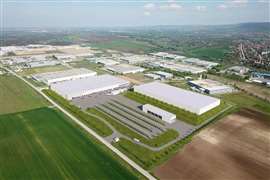View from China: Murray Pollok reports on the country's growing access industry.
11 August 2009

The world's biggest access manufacturers may be investing in China - Haulotte, JLG and Terex AWP are in the process of building their first factories there and Japan's Aichi is finishing off a second - but their Chinese competitors are not letting them have it all their own way.
China's access market may well be relatively undeveloped, but - as AI discovered when it visited three Chinese manufacturers in June - many of the country's domestic manufacturers continue to invest in their production facilities both for the anticipated increase in domestic demand and for export purposes, despite the collapse in western access markets.
"We can't wait for the European market to recover - we have to meet the demand from the domestic market", says Mr Xu Shugen, the young founder and managing director of Zhejiang Dingli Machinery Co (Dingli), a manufacturer of self-propelled aerial platforms and material handling equipment based in Hangzhou, 200 km south of Shanghai.
That's why the manufacturer is building a new 46000 m2 facility to produce an extended range of large self propelled aerial platforms, targeted mainly at the Chinese market. The RMB20 million (€2.1 million) investment is part of a strategy to refocus on domestic sales in response to a decline in Dingli's traditional export markets, including Europe.
Mr Xu tells Access International that export sales were down 70% in the first four months of the year, which is bad timing for a company that only CE marked its diesel powered booms and scissor lifts in late 2008.
Mr Xu says domestic demand for its access product continues to grow, helped by a massive economic stimulus package, much of which is focused on infrastructure. "The stimulus package will have a two year impact. After that, the Chinese economy will still rely on recovery of the world economy." He says there was growing demand for large booms from Chinese shipyards, utility companies and government bodies.
The assembly facility is scheduled to open in October this year and is very close to Dingli's recently completed main production facility in Hangzhou. It will make rough terrain scissors and the company's current 16 m articulated and telescopic booms. Planned production also includes 26/28 m, 30/32 m and 36/38 m telescopic booms.
Mr Xu tells AI that although Dingli remains committed to exporting - for example, Spanish rental company GAM currently has a Dingli 16 m articulated boom and 18 m rough terrain scissor on trial in Spain - the company needed to pursue opportunities in China until its European and other export markets recover.
Dingli's sales are concentrated on smaller electric scissors, vertical mast platforms and material handling products, such as pallet trucks. Exports represented two-thirds of its RMB160 million (€16.6 million) sales last year.
Meanwhile, Mr Wang Hua Long, co-founder, majority owner and chief executive officer of GJJ, the Guangzhou-based construction hoist and tower crane manufacturer, says that Chinese demand has picked-up again after a slowdown from September last year following the onset of the financial crisis. Like Mr Xu at Dingli, he credits the Chinese government's stimulus package and continued investment in infrastructure projects.
Mr Wang tells AI that half of the company's RMB780 million (€81 million) output last year was exported, but that this has now shifted to around 70% domestic sales because of the slowdown in its US, Canadian and Australian exports.
However, he says GJJ was prepared for this and had already started to focus on other export markets such as India (where it has sold around 60 hoists this year), the Middle East and Africa (Nigeria and Tanzania). Its Middle East dealer, NFT, sells the GJJ hoists under the Orbit brand.
If exports are impacted, domestic demand continues to spur GJJ to invest in production facilities. It has a very ambitious, three year project to build a new supply chain and manufacturing plant in Tianjin. The facility is a joint venture between GJJ and six of its key component suppliers.
The companies will together invest RMB800 million (€83 million) - with GJJ funding half of that sum - to develop the 360000 m2 site to manufacture hoists and hoist-related components such as motors, rack and pinions and safety devices.
GJJ's revenues are growing by virtue of its expanded production capacity. Last year it invested RMB200 million (€21 million) in a 50000 m2 hoist and tower crane factory in Xian, central China, which started operation in the middle of last year and is now in full production.
Mr Wang tells AI that the investment was necessary to provide capacity for domestic demand, as well as the company's longer-term export aims. GJJ already has two production facilities in Guangzhou, a tower crane plant in Changsha, and the new Xian factory.
He says the Xian facility will also be well located to serve the growing market in western China; "The Xian area is a new economic development zone and will grow like Guangzhou did five years ago".
The additional capacity provided by the Xian plant - which will make 150 tower cranes and 400 hoists this year - could increase turnover in 2009 to RMB 1 billion (€104 million). "I think we can do it. The new factory will allow us to sell tower cranes worth RMB 250 million (€26 million) this year, and we could produce 1500 hoists", says Mr Wang.
Anyone who has travelled in China will have seen the enormous potential for powered access equipment. At present, scaffolding - both steel and wooden - is almost the sole means of access on construction and industrial projects, while smaller vertical mast platforms can be seen at some airports, shopping malls and manufacturing facilities. Larger self-propelled booms are used at shipyards and there are some truck mounted platforms used by power and telecom utility companies.
For a Chinese manufacturer like Beijing JingCheng Heavy Industry, based in Beijing, however, the modest rate of growth for powered access in China is frustrating, and has led the company in the last few years to attempt exports and attend international shows like the APEX aerial platform event in the Netherlands last year.
Mr Su Jie, chairman and chief executive officer of JingCheng, tells AI that he believes the Chinese government will tighten up on health and safety regulations - leading to more demand for powered access - but he doesn't know when. Similarly, he believes that rental will eventually take off, although again he says it will take time, especially in the absence of any aggressive domestic rental players.
Although access is still a very small part of JingCheng's total business - RMB50 million (€5.2 million) last year out of a total turnover of RMB2.5 billion (€260 million) - Mr Su says the company is committed to expanding into the aerials sector; "JingCheng will focus on more engineered products - self-propelled booms and scissors."
It already makes a wide range of self-propelled telescopic booms, small electric scissors, trailer mounted platforms, a couple of wheeled ‘Spider' type platforms, and has met with some export success, for example, selling small utility booms for mounting onto vehicles for a Canadian company, and marketing its trailer mounts in the Middle East and South Africa.
Mr Su says exhibiting at APEX last year was a way of promoting the brand in international markets and to learn from western manufacturers.
Meanwhile, the company continues to focus on its other businesses, which comprise joint ventures with Chinese, Japanese and Korean manufacturers. (It builds 5.5 - 26 t excavators for Hyundai; truck crane chassis and hydraulic components for Tadano; dump trucks for a Singapore company; and axles and transmissions for Chinese partners.)
One of the keys to access growth, of course, is the development of a rental industry - that would be one aspect of the aerial lift business that western manufacturers wouldn't mind seeing copied in China.
Of the companies visited by AI, there was widespread mention of Hertz's efforts to create a rental business in Shanghai, with some seeing the US company as playing an important role in developing China's rental industry.
It is in that context that Xu Shugen of Dingli says he welcomes plans by JLG, Terex AWP and Haulotte to start manufacturing platforms in China, alongside Hertz's investment; "I'm not scared of [western manufacturers]. It will help improve the quality of the Chinese aerial platform industry. They will help the rental industry to develop."
Mr Xu says the Chinese authorities are against imports of used aerial platforms - and used equipment in general - in order to encourage domestic production. He says it is unlikely that this policy will change, and that used machines were not the way to develop the Chinese market.
Some manufacturers are tempted to enter the rental market. Mr Xu, for example, says he has thought about it, but says - take note - that he would prefer to help other western rental companies enter the market.
In the meantime, Chinese manufacturers will continue to expand, and will increasingly target exports - as their Chinese peers in construction equipment manufacturing, including Sany, Sunward and LiuGong, are already doing.
GJJ, for example, is even considering setting up its own overseas assembly factories in developing markets like the Middle East, India or Russia. There is no doubting the current contrast in fortunes between manufacturers in the west and China. GJJ's Mr Wang has an unsentimental view about that; "The world needs new companies. Manufacturers don't necessarily last for ever."


